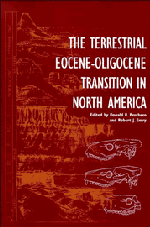Book contents
- Frontmatter
- Contents
- Contributors
- Preface
- PART I The Chronostratigraphy of the Uintan through Arikareean
- PART II Common Vertebrates of the White River Chronofauna
- 16 Testudines
- 17 Squamata
- 18 Ischyromyidae
- 19 Cylindrodontidae
- 20 Castoridae
- 21 Canidae
- 22 Nimravidae
- 23 Amphicyonidae
- 24 Small Arctoid and Feliform Camivorans
- 25 Merycoidodontinae and Miniochoerinae
- 26 Leptaucheniinae
- 27 Leptomerycidae
- 28 Camelidae
- 29 Hyracodontidae
- Summary
- Index
29 - Hyracodontidae
Published online by Cambridge University Press: 06 July 2010
- Frontmatter
- Contents
- Contributors
- Preface
- PART I The Chronostratigraphy of the Uintan through Arikareean
- PART II Common Vertebrates of the White River Chronofauna
- 16 Testudines
- 17 Squamata
- 18 Ischyromyidae
- 19 Cylindrodontidae
- 20 Castoridae
- 21 Canidae
- 22 Nimravidae
- 23 Amphicyonidae
- 24 Small Arctoid and Feliform Camivorans
- 25 Merycoidodontinae and Miniochoerinae
- 26 Leptaucheniinae
- 27 Leptomerycidae
- 28 Camelidae
- 29 Hyracodontidae
- Summary
- Index
Summary
ABSTRACT
The taxonomy of Hyracodon has long been confused by the variability of the cusps and crests on the upper premolars. Some authors have oversplit the genus into as many as 11 species, while others recognized only a single species. Based on much larger collections now available, I recognize five valid species of Hyracodon: H. primus from the Duchesnean; H. petersoni from the early Chadronian; H. priscidens from the early and middle Chadronian; the highly variable type species, H. nebraskensis, from the late Chadronian to early Arikareean; and the larger H. leidyanus from the Whitney an and early Arikareean. Both H. nebraskensis and H. leidyanus last appear in the lower Sharps Formation, and their extinction coincides with the early Arikareean faunal reorganization.
INTRODUCTION
In 1850, Joseph Leidy published the first notice of North American rhinoceroses. In a few brief paragraphs, he described (but did not illustrate) some teeth he called Rhinoceros occidentalis (now referred to the rhinocerotid taxon Subhyracodon occidentalis) and Rhinoceros nebraskensis. In 1851, Leidy placed both R. occidentalis and R. nebrascensis (misspelled by Leidy and most later authors from this point onward with a “c” instead of a “k”) in the European Oligocene-Miocene genus Aceratherium, because their teeth had cingula, unlike living Rhinoceros. Finally, in 1852 Leidy gave a full description and illustration of R. nebrascensis. He figured and discussed these specimens at length in his 1853 monograph on the “Ancient Fauna of Nebraska.”
- Type
- Chapter
- Information
- The Terrestrial Eocene-Oligocene Transition in North America , pp. 652 - 663Publisher: Cambridge University PressPrint publication year: 1996



